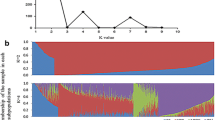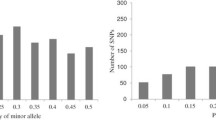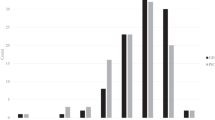Summary
Restriction fragment length polymorphisms have become powerful tools for genetic investigations in plant species. They allow a much greater degree of genome saturation with neutral markers than has been possible with isozymes or morphological loci. A previous investigation employed isozymes as genetic markers to infer the location of genetic factors influencing the expression of quantitative traits in the maize population: (CO159×Tx303)F2. This investigation was conducted to examine the inferences that might be derived using a highly saturated map of RFLP markers and isozymes to detect quantitative trait loci (QTLs) in the same maize F2 population. Marker loci that were associated with QTL effects in this investigation generally corresponded well with previous information where such comparisons were possible. Additionally, a number of previously unmarked genomic regions were found to contain factors with large effects on some plant traits. Availability of numerous marker loci in some genomic regions allowed: more accurate localization of QTLs, resolution of linkage between QTLs affecting the same traits, and determination that some chromsome regions previously found to affect a number of traits are likely to be due to linkage of QTLs affecting different traits. Many of the factors that affected plant height quantitatively in this investigation were found to map to regions also including known sites of major genes influencing plant height. Although the data are not conclusive, they suggest that some of the identified QTLs may be allelic to known major genes affecting plant height.
Similar content being viewed by others
References
Baker RJ (1984) Quantitative genetic principles in plant breeding. In: Gustafson JP (ed) Gene manipulation in plant improvement. Proc 16th Stadler Genet Symp, University of Missouri, Columbia. Plenum Press, London, pp 147–176
Barnatzky R, Tanksley SD (1986) Toward a saturated linkage map in tomato based on isozymes and random cDNA sequences. Genetics 112:887–898
Burr B, Burr FA, Thompson KH, Albertson MC, Stuber CW (1988) Gene map** with recombinant inbreds in maize. Genetics 118:519–526
Cardy BJ, Stuber CW, Wendel JF, Goodman MM (1983) Techniques for starch gel electrophoresis of enzymes from maize (Zea mays L.). Inst, of Stat. Mimeo. Ser. No. 1317 R. North Carolina State University., Raleigh/NC
Coe E, Hoisington D, Chao S (1990) Gene list and working maps. Maize Genet Coop Newslett 64:134–163
Edwards MD, Stuber CW (1986) Molecular-marker-facilitated selection for yield enhancing genes in two maize populations. American Society of Agronomy, 1986 Annual Meeting, New Orleans/LA (Abstr.)
Edwards MD, Stuber CW, Wendel JF (1987) Molecular-markerfacilitated investigations of quantitative trait loci in maize. I. Numbers, genomic distribution and types of gene action. Genetics 116:113–125
Helentjaris T, Slocum M, Wright S, Schaefer A, Nienhuis J (1986) Construction of genetic linkage maps in maize and tomato using restriction fragment length polymorphisms. Theor Appl Genet 72:761–769
Helentjaris T, Weber D, Wright S (1988) Identification of the genomic locations of duplicate nucleotide sequences in maize by analysis of restriction fragment length polymorphisms. Genetics 118:353–363
Kahler AL (1985) Associations between enzyme marker loci and agronomic traits in maize. In: Proc 40th Annu Corn and Sorghum Res Conf. American Seed Trade Association, Washington, D.C., pp 66–89
Lande R (1981) The minimum number of genes contributing to quantitative variation between and within populations. Genetics 99:541–553
Mather K, **ks JL(1971) Biometrical genetics. Cornell University Press, Ithaca/NY
Nienhuis J, Helentjaris T, Slocum M, Ruggero B, Schaefer A (1987) Restriction fragment length polymorphism analysis of loci associated with insect resistance in tomato. Crop Sci 27:797–803
Ohta T (1980) Evolution and variation of multigene families. Springer, Berlin
Ohno S (1970) Evolution by gene duplication. Springer, Berlin
Osborn TC, Alexander DC, Fobes JF (1987) Identification of restriction fragment length polymorphisms linked to genes controlling soluble solids content in tomato fruit. Theor Appl Genet 73:350–356
Park YC (1977) Theory for the number of genes affecting quantitative characters. 2. Biases from drift, inequality of gene effects, linkage disequilibrium and epistasis. Theor Appl Genet 50:163–172
Paterson AH, Lander ES, Hewitt JD, Peterson S, Lincoln SE, Tanksley SD (1988) Resolution of quantitative traits into Mendelian factors by using a complete RFLP linkage map. Nautre 335:721–726
Phillips RL (1986) Implications of molecular genetic theory to corn breeding. In: Proc 18th Annual Illinois Corn Breeders School, Urbana-Champaign/IL, pp 14–28
Soller M, Brody T, Genizi A (1979) The expected distribution of marker-linked quantitative effects in crosses between inbred lines. Heredity 43:179–190
Stuber CW, Edwards MD (1986) Genotypic selection for improvement of quantitative traits in corn using molecular marker loci. In: Proc 41st Annu Corn and Sorghum Res Conf. American Seed Trade Association, Washington D.C., pp 70–83
Stuber CW, Edwards MD, Wendel JF (1987) Molecular-markerfacilitated investigations of quantitative trait loci in maize. II. Factors influencing yield and its component traits. Crop Sci 27:639–648
Stuber CW, Wendel JF, Goodman MM, Smith JSC (1988) Techniques and scoring procedures for starch gel electrophoresis of enzymes from maize. N.C. State Univ Agric Res Serv Bull 286, Raleigh/NC
Suiter KA, Wendel JF, Case JS (1983) Linkage-1: a PASCAL computer program for the detection and analysis of genetic linkage. J Hered 74:203–204
Tanksley SD, Hewitt J (1988) Use of molecular markers in breeding for soluble solids content in tomato — a re-examination. Theor Appl Genet 75:811–823
Tanksley SD, Medina-Filho H, Rick CM (1982) Use of naturally occurring enzyme variation ot detect and map genes controlling quantitative traits in an interspecific backcross of tomato. Heredity 49:11–25
Thompson JN Jr (1975) Quantitative variation and gene number. Nature 258:665–668
Weller JI, Soller M, Brody T (1988) Linkage analysis of quantitative traits in an interspecific cross of tomato (Lycopersicon esculentum x Lycopersicon pimpinellifolium) by means of genetic markers. Genetics 118:329–339
Author information
Authors and Affiliations
Additional information
Communicated by A. R. Hallauer
Rights and permissions
About this article
Cite this article
Edwards, M.D., Helentjaris, T., Wright, S. et al. Molecular-marker-facilitated investigations of quantitative trait loci in maize. Theoret. Appl. Genetics 83, 765–774 (1992). https://doi.org/10.1007/BF00226696
Received:
Accepted:
Issue Date:
DOI: https://doi.org/10.1007/BF00226696




